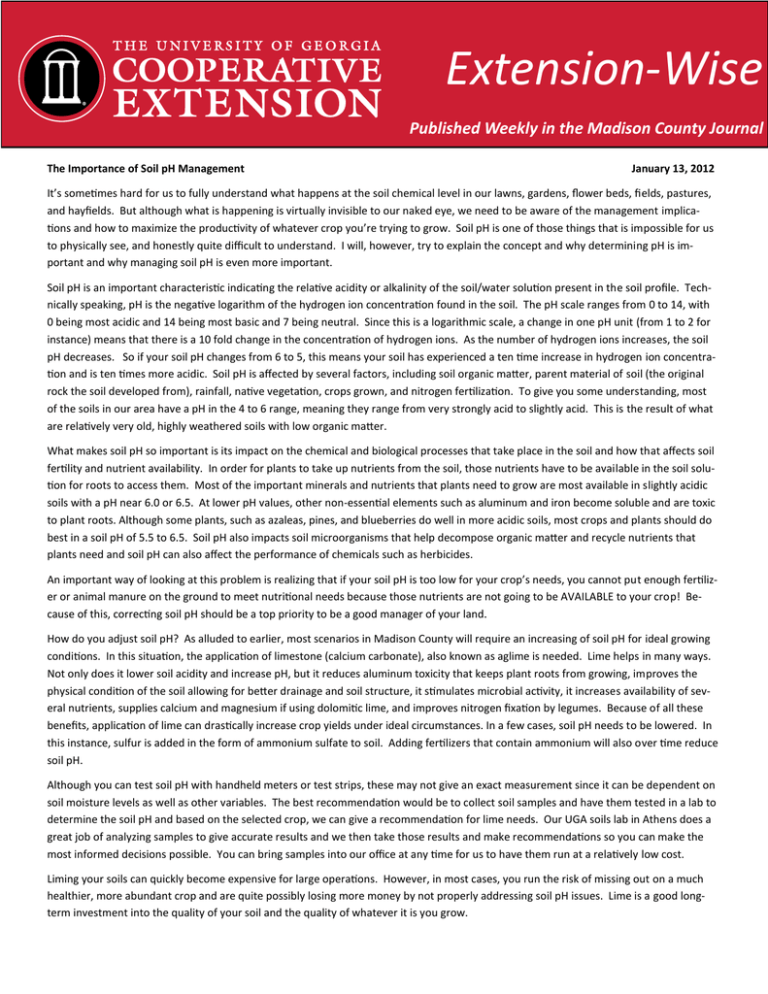Extension-Wise Published Weekly in the Madison County Journal
advertisement

Extension-Wise Published Weekly in the Madison County Journal The Importance of Soil pH Management January 13, 2012 It’s sometimes hard for us to fully understand what happens at the soil chemical level in our lawns, gardens, flower beds, fields, pastures, and hayfields. But although what is happening is virtually invisible to our naked eye, we need to be aware of the management implications and how to maximize the productivity of whatever crop you’re trying to grow. Soil pH is one of those things that is impossible for us to physically see, and honestly quite difficult to understand. I will, however, try to explain the concept and why determining pH is important and why managing soil pH is even more important. Soil pH is an important characteristic indicating the relative acidity or alkalinity of the soil/water solution present in the soil profile. Technically speaking, pH is the negative logarithm of the hydrogen ion concentration found in the soil. The pH scale ranges from 0 to 14, with 0 being most acidic and 14 being most basic and 7 being neutral. Since this is a logarithmic scale, a change in one pH unit (from 1 to 2 for instance) means that there is a 10 fold change in the concentration of hydrogen ions. As the number of hydrogen ions increases, the soil pH decreases. So if your soil pH changes from 6 to 5, this means your soil has experienced a ten time increase in hydrogen ion concentration and is ten times more acidic. Soil pH is affected by several factors, including soil organic matter, parent material of soil (the original rock the soil developed from), rainfall, native vegetation, crops grown, and nitrogen fertilization. To give you some understanding, most of the soils in our area have a pH in the 4 to 6 range, meaning they range from very strongly acid to slightly acid. This is the result of what are relatively very old, highly weathered soils with low organic matter. What makes soil pH so important is its impact on the chemical and biological processes that take place in the soil and how that affects soil fertility and nutrient availability. In order for plants to take up nutrients from the soil, those nutrients have to be available in the soil solution for roots to access them. Most of the important minerals and nutrients that plants need to grow are most available in slightly acidic soils with a pH near 6.0 or 6.5. At lower pH values, other non-essential elements such as aluminum and iron become soluble and are toxic to plant roots. Although some plants, such as azaleas, pines, and blueberries do well in more acidic soils, most crops and plants should do best in a soil pH of 5.5 to 6.5. Soil pH also impacts soil microorganisms that help decompose organic matter and recycle nutrients that plants need and soil pH can also affect the performance of chemicals such as herbicides. An important way of looking at this problem is realizing that if your soil pH is too low for your crop’s needs, you cannot put enough fertilizer or animal manure on the ground to meet nutritional needs because those nutrients are not going to be AVAILABLE to your crop! Because of this, correcting soil pH should be a top priority to be a good manager of your land. How do you adjust soil pH? As alluded to earlier, most scenarios in Madison County will require an increasing of soil pH for ideal growing conditions. In this situation, the application of limestone (calcium carbonate), also known as aglime is needed. Lime helps in many ways. Not only does it lower soil acidity and increase pH, but it reduces aluminum toxicity that keeps plant roots from growing, improves the physical condition of the soil allowing for better drainage and soil structure, it stimulates microbial activity, it increases availability of several nutrients, supplies calcium and magnesium if using dolomitic lime, and improves nitrogen fixation by legumes. Because of all these benefits, application of lime can drastically increase crop yields under ideal circumstances. In a few cases, soil pH needs to be lowered. In this instance, sulfur is added in the form of ammonium sulfate to soil. Adding fertilizers that contain ammonium will also over time reduce soil pH. Although you can test soil pH with handheld meters or test strips, these may not give an exact measurement since it can be dependent on soil moisture levels as well as other variables. The best recommendation would be to collect soil samples and have them tested in a lab to determine the soil pH and based on the selected crop, we can give a recommendation for lime needs. Our UGA soils lab in Athens does a great job of analyzing samples to give accurate results and we then take those results and make recommendations so you can make the most informed decisions possible. You can bring samples into our office at any time for us to have them run at a relatively low cost. Liming your soils can quickly become expensive for large operations. However, in most cases, you run the risk of missing out on a much healthier, more abundant crop and are quite possibly losing more money by not properly addressing soil pH issues. Lime is a good longterm investment into the quality of your soil and the quality of whatever it is you grow.






